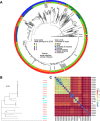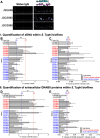Enhanced biofilm and extracellular matrix production by chronic carriage versus acute isolates of Salmonella Typhi
- PMID: 33465146
- PMCID: PMC7815147
- DOI: 10.1371/journal.ppat.1009209
Enhanced biofilm and extracellular matrix production by chronic carriage versus acute isolates of Salmonella Typhi
Erratum in
-
Correction: Enhanced biofilm and extracellular matrix production by chronic carriage versus acute isolates of Salmonella Typhi.PLoS Pathog. 2021 Apr 12;17(4):e1009512. doi: 10.1371/journal.ppat.1009512. eCollection 2021 Apr. PLoS Pathog. 2021. PMID: 33844705 Free PMC article.
Abstract
Salmonella Typhi is the primary causative agent of typhoid fever; an acute systemic infection that leads to chronic carriage in 3-5% of individuals. Chronic carriers are asymptomatic, difficult to treat and serve as reservoirs for typhoid outbreaks. Understanding the factors that contribute to chronic carriage is key to development of novel therapies to effectively resolve typhoid fever. Herein, although we observed no distinct clustering of chronic carriage isolates via phylogenetic analysis, we demonstrated that chronic isolates were phenotypically distinct from acute infection isolates. Chronic carriage isolates formed significantly thicker biofilms with greater biomass that correlated with significantly higher relative levels of extracellular DNA (eDNA) and DNABII proteins than biofilms formed by acute infection isolates. Importantly, extracellular DNABII proteins include integration host factor (IHF) and histone-like protein (HU) that are critical to the structural integrity of bacterial biofilms. In this study, we demonstrated that the biofilm formed by a chronic carriage isolate in vitro, was susceptible to disruption by a specific antibody against DNABII proteins, a successful first step in the development of a therapeutic to resolve chronic carriage.
Conflict of interest statement
The authors have declared that no competing interests exist.
Figures




Similar articles
-
DNABII proteins play a central role in UPEC biofilm structure.Mol Microbiol. 2015 Jun;96(6):1119-35. doi: 10.1111/mmi.12994. Epub 2015 Apr 16. Mol Microbiol. 2015. PMID: 25757804 Free PMC article.
-
Pathoadaptive Alteration of Salmonella Biofilm Formation in Response to the Gallbladder Environment.J Bacteriol. 2019 Jun 21;201(14):e00774-18. doi: 10.1128/JB.00774-18. Print 2019 Jul 15. J Bacteriol. 2019. PMID: 30962351 Free PMC article.
-
Establishment of Chronic Typhoid Infection in a Mouse Carriage Model Involves a Type 2 Immune Shift and T and B Cell Recruitment to the Gallbladder.mBio. 2019 Oct 1;10(5):e02262-19. doi: 10.1128/mBio.02262-19. mBio. 2019. PMID: 31575775 Free PMC article.
-
Shedding light on Salmonella carriers.Trends Microbiol. 2012 Jul;20(7):320-7. doi: 10.1016/j.tim.2012.04.004. Epub 2012 May 14. Trends Microbiol. 2012. PMID: 22591832 Review.
-
Biofilm Producing Salmonella Typhi: Chronic Colonization and Development of Gallbladder Cancer.Int J Mol Sci. 2017 Aug 31;18(9):1887. doi: 10.3390/ijms18091887. Int J Mol Sci. 2017. PMID: 28858232 Free PMC article. Review.
Cited by
-
Functional role of the biofilm regulator CsgD in Salmonella enterica sv. Typhi.Front Cell Infect Microbiol. 2024 Dec 11;14:1478488. doi: 10.3389/fcimb.2024.1478488. eCollection 2024. Front Cell Infect Microbiol. 2024. PMID: 39720794 Free PMC article.
-
Multiple biological characteristics and functions of intestinal biofilm extracellular polymers: friend or foe?Front Microbiol. 2024 Aug 19;15:1445630. doi: 10.3389/fmicb.2024.1445630. eCollection 2024. Front Microbiol. 2024. PMID: 39224216 Free PMC article. Review.
-
Correction: Enhanced biofilm and extracellular matrix production by chronic carriage versus acute isolates of Salmonella Typhi.PLoS Pathog. 2021 Apr 12;17(4):e1009512. doi: 10.1371/journal.ppat.1009512. eCollection 2021 Apr. PLoS Pathog. 2021. PMID: 33844705 Free PMC article.
-
Bacterial Biofilms Utilize an Underlying Extracellular DNA Matrix Structure That Can Be Targeted for Biofilm Resolution.Microorganisms. 2022 Feb 18;10(2):466. doi: 10.3390/microorganisms10020466. Microorganisms. 2022. PMID: 35208922 Free PMC article. Review.
-
The epidemiology and impact of persistent Campylobacter infections on childhood growth among children 0-24 months of age in resource-limited settings.EClinicalMedicine. 2024 Sep 28;76:102841. doi: 10.1016/j.eclinm.2024.102841. eCollection 2024 Oct. EClinicalMedicine. 2024. PMID: 39380966 Free PMC article.
References
Publication types
MeSH terms
Substances
Grants and funding
- BBS/E/F/000PR10349/BB_/Biotechnology and Biological Sciences Research Council/United Kingdom
- BBS/E/F/000PR10348 /BB_/Biotechnology and Biological Sciences Research Council/United Kingdom
- 215515/Z/19/Z/WT_/Wellcome Trust/United Kingdom
- R21 AI153752/AI/NIAID NIH HHS/United States
- BB/R012504/1/BB_/Biotechnology and Biological Sciences Research Council/United Kingdom
LinkOut - more resources
Full Text Sources
Other Literature Sources

